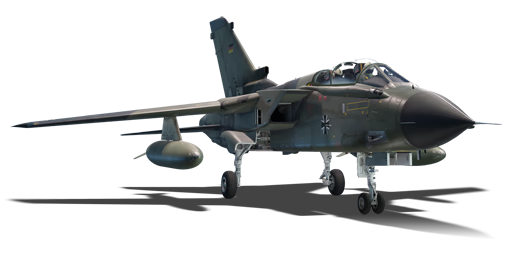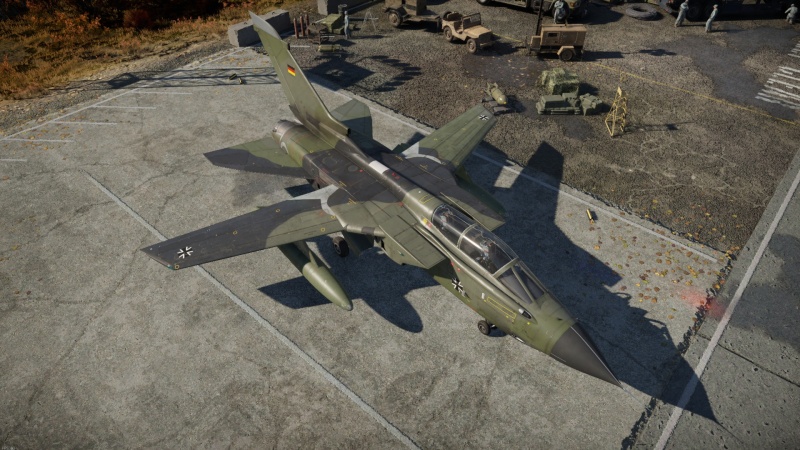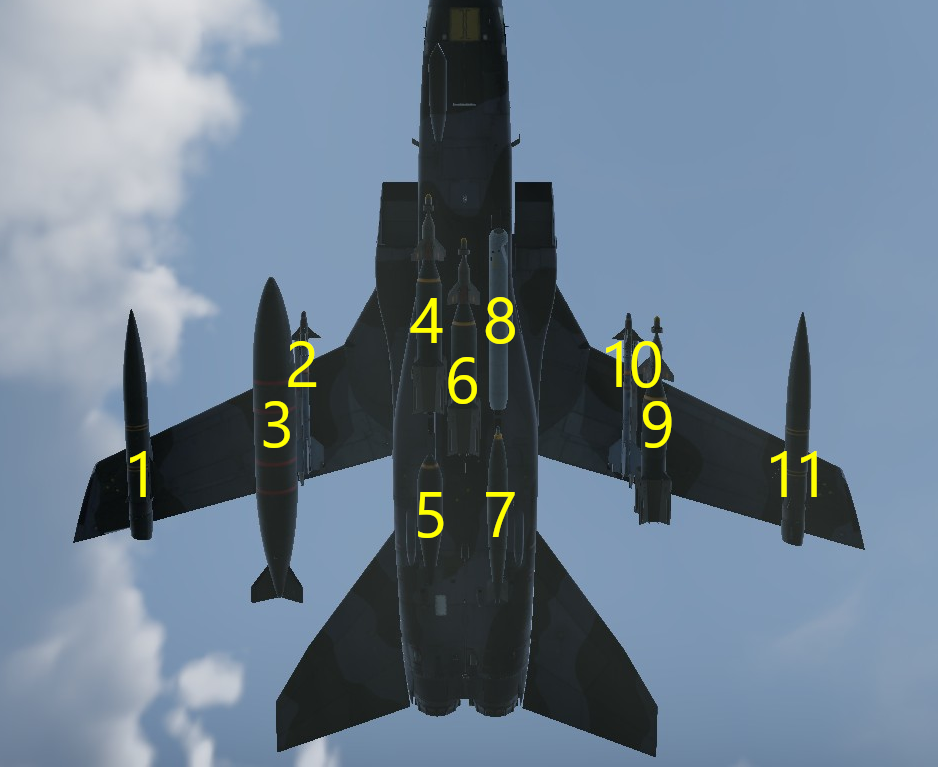Difference between revisions of "Tornado IDS ASSTA1 (Germany)"
Colok76286 (talk | contribs) (→Media: Added skins) |
Colok76286 (talk | contribs) (→Media: Added Shooting Range episode) |
||
| Line 238: | Line 238: | ||
;Skins | ;Skins | ||
* [https://live.warthunder.com/feed/camouflages/?vehicle=tornado_ids_de_assta1 Skins and camouflages for the {{PAGENAME}} from live.warthunder.com.] | * [https://live.warthunder.com/feed/camouflages/?vehicle=tornado_ids_de_assta1 Skins and camouflages for the {{PAGENAME}} from live.warthunder.com.] | ||
| + | |||
| + | ;Videos | ||
| + | {{Youtube-gallery|3kVkp5-IeNQ|'''The Shooting Range #340''' - ''Metal Beasts'' section at 00:24 discusses the {{PAGENAME}}.}} | ||
== See also == | == See also == | ||
Revision as of 20:12, 6 February 2023
| This page is about the strike aircraft Tornado IDS ASSTA1 (Germany). For other versions, see Tornado (Family). |
Contents
Description
The ◄Tornado IDS ASSTA1 is a rank VIII German strike aircraft with a battle rating of 11.7 (AB/RB/SB). It was introduced in Update "Apex Predators". The Panavia 200 (PA-200) Tornado is a two-seat, twin-engine, swing-wing, multi-role combat aircraft built jointly by Germany, the United Kingdom, and Italy. This version is the Tornado Interdiction/Strike or IDS, and was intended as a low-flying fighter bomber armed with precision weapons.
Its first combat missions were in the second Gulf War by the British, Italian and Saudi Arabian air forces. This was later followed by missions in the Yugoslavian and Kosovo wars, in which the Bundeswehr also participated for the first time. German Tornados also flew reconnaissance missions as part of the ISAF mission and in northern Iraq.
General info
Flight performance
Describe how the aircraft behaves in the air. Speed, manoeuvrability, acceleration and allowable loads - these are the most important characteristics of the vehicle.
| Characteristics | Max speed (km/h at _,___ m) |
Max altitude (metres) |
Turn time (seconds) |
Rate of climb (metres/second) |
Take-off run (metres) | |||
|---|---|---|---|---|---|---|---|---|
| AB | RB | AB | RB | AB | RB | |||
| Stock | ___ | ___ | 13500 | __._ | __._ | __._ | __._ | ___ |
| Upgraded | ___ | ___ | __._ | __._ | __._ | __._ | ||
Details
| Features | |||||
|---|---|---|---|---|---|
| Combat flaps | Take-off flaps | Landing flaps | Air brakes | Arrestor gear | Drogue chute |
| ✓ | ✓ | ✓ | ✓ | ✓ | X |
| Limits | Wings (km/h) | Gear (km/h) | Flaps (km/h) | Max Static G | |||
|---|---|---|---|---|---|---|---|
| Combat | Take-off | Landing | + | - | |||
| Min sweep | 972 | 520 | 972 | 552 | 440 | ~__ | ~__ |
| Max sweep | 1,555 | N/A | N/A | N/A | ~__ | ~__ | |
| Optimal velocities (km/h) | |||
|---|---|---|---|
| Ailerons | Rudder | Elevators | Radiator |
| < ___ | < ___ | < ___ | N/A |
Engine performance
| Engine | Aircraft mass | |||||||
|---|---|---|---|---|---|---|---|---|
| Engine name | Number | Basic mass | Wing loading (full fuel) | |||||
| Turbo-Union RB199-34R Mk.103 | 2 | 14,709 kg | ___ kg/m2 | |||||
| Engine characteristics | Mass with fuel (no weapons load) | Max Gross Weight | ||||||
| Weight (each) | Type | 16m fuel | 20m fuel | 30m fuel | 45m fuel | 56m fuel | ||
| 968 kg | Afterburning low-bypass turbofan | 16,236 kg | 16,523 kg | 17,429 kg | 18,789 kg | 19,799 kg | 26,310 kg | |
| Maximum engine thrust @ 0 m (RB/SB) | Thrust to weight ratio @ 0 m (WEP) | |||||||
| Condition | 100% | WEP | 16m fuel | 20m fuel | 30m fuel | 45m fuel | 56m fuel | MGW |
| Stationary | 3,777 kgf | 7,293 kgf | 0.90 | 0.88 | 0.84 | 0.78 | 0.74 | 0.55 |
| Optimal | 4,192 kgf (1,400 km/h) |
8,155 kgf (1,400 km/h) |
1.00 | 0.99 | 0.94 | 0.87 | 0.82 | 0.62 |
Survivability and armour
The Tornado has no armour to speak of and is relatively large, making it an easy target for enemy guns. Almost any hit to the center part of the Tornado will leave its speed crippled, while any hit to the wings and tail will most likely cripple flight performance, if not disabling the aircraft outright. Although it could in theory make its way back to base even with only one engine, any enemy attention during this timespan will most likely get you sent back to the hangar. It also has 2 pilots, which means that you can continue flying in the unlikely case that only 1 pilot is knocked out.
Modifications and economy
Armaments
| Ballistic Computer | |||
|---|---|---|---|
| CCIP (Guns) | CCIP (Rockets) | CCIP (Bombs) | CCRP (Bombs) |
| |
|
|
|
Offensive armament
The Tornado IDS ASSTA1 (Germany) is armed with:
- 2 x 27 mm Mauser BK27 cannons, chin-mounted (180 rpg = 360 total)
Suspended armament
The Tornado IDS ASSTA1 (Germany) can be outfitted with the following ordnance presets:
- 2 x 1,500 l drop tanks
- 56 x large calibre countermeasures
- 2 x AIM-9L Sidewinder missiles
- 7 x 1,000 lb LDGP Mk 83 bombs (7,000 lb total)
- 12 x 1,000 lb LDGP Mk 83 bombs (12,000 lb total)
- 4 x 1,092 lb GBU-16 Paveway II bombs (4,368 lb total)
- 1 x 2,000 lb GBU-24 Paveway III bomb (2,000 lb total)
Custom loadout options
| 1 | 2 | 3 | 4 | 5 | 6 | 7 | 8 | 9 | 10 | 11 | ||
|---|---|---|---|---|---|---|---|---|---|---|---|---|
| 1,000 lb LDGP Mk 83 bombs | 1, 2 | 1, 2‡ | 1, 2‡ * | 1‡ | 1, 2‡ | 1, 2‡ | 1, 2 | |||||
| 1,092 lb GBU-16 Paveway II bombs | 1† | 1*† | 1†‡ | 1† | ||||||||
| 2,000 lb GBU-24 Paveway III bombs | 1*† | |||||||||||
| AIM-9L Sidewinder missiles | 1 | 1 | ||||||||||
| Large calibre countermeasures | 28 | 28 | ||||||||||
| LITENING II | 1† | |||||||||||
| 1,500 l drop tanks | 1 | 1 | ||||||||||
| * Guided bombs on hardpoint 4 cannot be equipped with 1,000 lb bombs on hardpoint 5-6 † LITENING II targeting pod must be equipped when using guided bombs ‡ Bombs on hardpoint 6 cannot be equipped with dual bomb mounts on hardpoints 4-8 or GBU-24 on hardpoint 4 | ||||||||||||
Usage in battles
There are multiple ways to use the Tornado in ARB, one tactic is to stick to the team and try and give support with your AIM-9Ls on your way to the enemy bases and/or ground targets. This gives you the advantage of team cover and a bit of safety, although you will undoubtedly be in the midst of battle once enemy interceptors and fighters reach your team. The other tactic would be to go full throttle directly to the enemy bases while keeping extremely low to the ground to decrease your chances of being spotted visually or by radar. While this leaves you mostly alone and isolated from the possible support of your team, you will be able to take a more direct route to your main target, meaning you'll be able to evade any slower or unsuspecting enemies. Taking an active role in air-to-air combat is not advised, as the Tornado's flight performance is not suited to it and you'll most likely be shot down very quickly. In the case of 1-to-1 confrontation the best option is to simply hope you are faster and run away, against capable fighters like the MiG-23, F-16, MiG-29, Viggen, F-14, and Mirage 2000 you don't stand a chance, unless the enemy pilot is extremely inexperienced.
Pros and cons
Pros:
- High acceleration
- Laser-guided munitions give it a good ground attack capability
Cons:
- Bombs severely limit its maximum speed to about Mach 1.05
- Very sluggish and slow turning rate, is unable to effectively manoeuvre
- Only has access to 2 x AIM-9L for air-to-air purposes
- No search radar
- Tracking radar is limited to 5°x6° and has 2 km effective range
History
In 1967, the Netherlands, Belgium, Canada, Italy, and the Federal Republic of Germany joined together to form the F-104 Replacement Group to begin joint planning for a Multi-Role Aircraft 75 (MRA-75) as a successor to the Starfighter.
In the UK, there was a need for a successor to the Canberra at the same time. Initially, work was done here on a national development, the BAC TSR.2. After this project was discontinued in 1965, development of a joint swing-wing fighter began with France under the Anglo-French Variable Geometry (AFVG) program. In addition, British forces were looking at introducing the General Dynamics F-111. However, France withdrew from the AFVG project in June 1967, and about six months later the British gave up their option to buy the F-111.
Britain decided to participate in a joint project in 1967 after initial coordination discussions with the F-104 Replacement Group nations. In 1968, the participating countries signed an initial memorandum that aimed at a joint project called the Multi-Role Combat Aircraft (MRCA). At this point, Canada and Belgium withdrew their intentions to participate, followed shortly thereafter by the Netherlands.
In 1969, the definition phase began. The concept of the swing-wing was retained because of its versatility. The goal of the remaining nations, Germany, Italy and Great Britain, was to build a multi-role combat aircraft that could be used for conventional as well as nuclear air attacks, aerial reconnaissance and naval warfare from the air. The Warsaw Pact was seen as an adversary with a strong air defense and, at the same time, the ability to take offensive action against NATO itself with a large force deployment. The emphasis of the resulting operational requirements was therefore on high assertiveness and robustness. To ensure this, the new aircraft was required, among other things, to be capable of extreme low-level flight and precise weapons employment in all weather conditions, day and night, and also to have highly effective self-protection equipment. In addition, it was to be capable of using runways damaged by enemy air attacks. The UK also defined a requirement for a long-range interceptor fighter.
To ensure adequate representation of the interests of the participating nations in this multinational project, their governments decided to establish a joint organization under the NATO umbrella, the NATO Multi-Role Combat Aircraft Development and Production Management Organization (NAMMO). A separate agency, NAMMA, was established as the executive body with personnel from the three nations. NAMMA's mission was expanded in 1987 to include in-service support (NATO Multi-Role Combat Aircraft Development, Production and In-Service Support Management Agency). The agency merged with NEFMA from the Eurofighter program in 1995 to form the NATO EF 2000 and Tornado Development, Production & Logistics Management Agency (NETMA).
The industrial groups involved in the program, British Aircraft Corporation (BAC), Messerschmitt-Bölkow-Blohm (MBB) and Fiat Aviazione, merged to form the independent international Panavia Aircraft GmbH, based in Munich, which had overall responsibility during the production phase and was the sole point of contact for NAMMA.
In 1969, the invitation to tender was issued for the development of the engine. Here, the British company Rolls-Royce came out on top with the Turbo-Union RB199 engine against the American manufacturers Pratt & Whitney and General Electric, partly because of the high degree of technology transfer offered to the other participating nations. The Turbo-Union Ltd. consortium, based in Great Britain and involving Rolls-Royce, Motoren- und Turbinen-Union (MTU) and Fiat, was set up to manufacture the engine.
Development began on July 20, 1970, after the United Kingdom had prevailed with the concept of the two-seat twin-engine aircraft; based on experience with the F-104 and the Fiat G.91 and for cost reasons, Germany had originally called for only one pilot and only one engine. The envisaged number of aircraft declined from 1,500 (GB: 300, D: 550, I: 200, others: 600) in 1968, including the British fighter version, to 809 (GB: 385, D: 324, I: 100) in 1972. Overall, delivery figures over the entire production and service period totaled: GB: 402, D: 357, I: 100. Production of the assemblies proceeded according to a division of labor. The cockpit and tail sections as well as the vertical stabilizer were manufactured by BAC (later BAE Systems), MBB (later DASA and EADS) produced the center fuselage section and the air intakes, and Fiat (later Aeritalia and Alenia Aeronautica) produced the wings with the high-lift aids. Final assembly took place from 1973 at three sites in Warton (Lancashire, UK), Manching (Germany) and Turin (Italy).
The maiden flight took place in Manching, Germany on August 14, 1974, and in 1976 the aircraft, until then designated MRCA, was given the name Tornado.
Series production began in 1979. In 1980, the first Tornado was delivered to the Tri-National Tornado Training Establishment (TTTE) at Cottesmore for flying crew training. Equipment for operational units in the United Kingdom and Germany began in 1982, followed by Italy in 1984 and Saudi Arabia, the sole export customer, in 1986.
In late 1989, the U.S. Department of Defense investigated whether the Tornado could be used by U.S. air forces in the Wild Weasel role to replace the Phantom F-4G. However, this consideration was discarded in the early 1990s in favor of the existing F-16s.
From 1990 to 1991, the German Electronic Combat and Reconnaissance (ECR) variants were produced, which would later play an important role in the Balkan War. In 1991, the South Korean Air Force expressed interest in purchasing 50 Tornado ECRs. Due to delays caused by technical problems, the number was initially reduced to 24, and eventually the intention was abandoned.
In 1995, 339 Tornado fighter aircraft were in service with the Bundeswehr (Air Force and German Navy). Production of the Tornados then ended in 1998, after a total of 992 had been produced.
Media
- Skins
- Videos
See also
External links
Paste links to sources and external resources, such as:
- topic on the official game forum;
- other literature.
| Panavia Aircraft GmbH | |
|---|---|
| Strike Aircraft | Tornado (Family) |
| Germany | ◄Tornado IDS WTD61 · ◄Tornado IDS ASSTA1 · ◄Tornado IDS MFG |
| UK | Tornado GR.1 · Tornado GR.4 · Tornado F.3 · Tornado F.3 Late |
| Italy | Tornado ADV · ▄Tornado IDS · ▄Tornado IDS (1995) |
| Germany jet aircraft | |
|---|---|
| |
Luftwaffe |
| He 162 | He 162 A-1 · He 162 A-2 |
| Me 163 | Me 163 B · Me 163 B-0 |
| Ho 229 | Ho 229 V3 |
| Ar 234 | Ar 234 B-2 · Ar 234 C-3 |
| Me 262 | Me 262 A-1a · Me 262 A-1a/Jabo · Me 262 A-1a/U1 · Me 262 A-1/U4 · Me 262 A-2a |
| Me 262 C-1a · Me 262 C-2b | |
| |
LSK |
| Fighters | ◊MiG-15bis · ◊Lim-5P · ◊MiG-19S |
| ◊MiG-21MF · ◊MiG-21bis-SAU · ◊MiG-21 "Lazur-M" | |
| ◊MiG-29 | |
| Attackers | ◊MiG-23BN · ◊MiG-23MF · ◊MiG-23MLA |
| ◊Su-22UM3K · ◊Su-22M4 | |
| ◊IL-28 | |
| |
Luftwaffe |
| F-84 | ◄F-84F |
| F-86 | ◄CL-13A Mk 5 · ◄CL-13B Mk.6 · ◄F-86K |
| F-104 | ◄F-104G |
| F-4 | ◄F-4F Early · ◄F-4F · ◄F-4F KWS LV |
| G.91 | ◄G.91 R/3 · ◄G.91 R/4 |
| Tornado | ◄Tornado IDS WTD61 · ◄Tornado IDS MFG · ◄Tornado IDS ASSTA1 |
| Other | Alpha Jet A · ◄Sea Hawk Mk.100 |
| Ex-LSK | ◄MiG-21 SPS-K · ◄MiG-29G · ◄Su-22M4 WTD61 |
| |
Swiss Air Force |
| ◌Hunter F.58 · FFA P-16 | |






